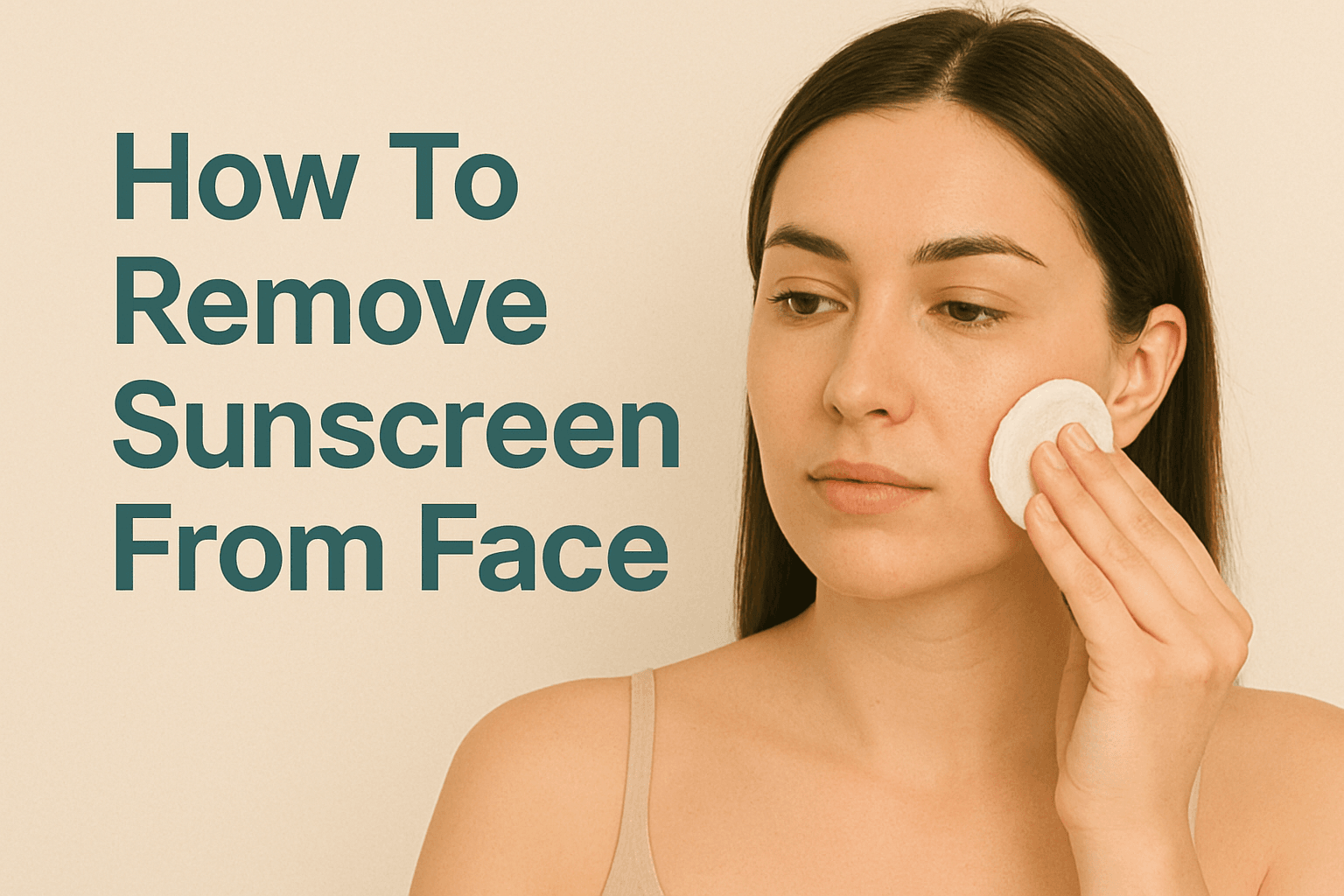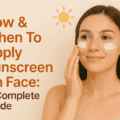As someone who loves spending time outdoors, I understand the importance of sunscreen in protecting our skin from the harmful effects of the sun. However, one common issue many of us face is the stubborn residue that sunscreen can leave behind on our faces. It can be frustrating to deal with, but fear not! In this article, I will share with you some effective methods on how to remove sunscreen from your face, leaving it clean and refreshed.
The Importance Of Removing Sunscreen Completely
No doubt there are tons of benefits of sunscreen for the face. But guess what? Properly removing sunscreen from your face is equally crucial for maintaining the health and appearance of your skin. The best sunscreens are designed to adhere to your skin and create a barrier against the sun’s harmful rays. However, if not removed properly, it can clog your pores, leading to breakouts and other skin issues. Additionally, the residue left behind can make your skin feel greasy and uncomfortable.
To avoid these problems, it’s essential to know how to remove sunblock from your face by incorporating a thorough sunscreen removal routine into your skincare regimen. By doing so, you can ensure that your skin remains clean, clear, and free from any sunscreen residue.
Common Methods For Removing Sunscreen From Your Face
Some common methods can be used when it comes to how to remove sunscreen from the skin. From using a mild cleanser to exfoliating, here are some methods you should know about.
1# Washing With Water & A Gentle Cleanser
The most basic and effective way to remove sunscreen from your face is to wash it off with water and a face cleanser. Start by wetting your face with lukewarm water, then apply a small amount of cleanser and massage it gently onto your skin. Rinse with water and pat dry. This method is suitable for all skin types and is an excellent option for daily use.
2# Using Micellar Water
Micellar water is a gentle and convenient option for removing sunscreen. Soak a cotton pad with micellar cleansing water and swipe it across your face, focusing on areas where you applied sunscreen. It effectively removes dirt, oil, and sunscreen residue without the need for rinsing. This method is particularly useful when you’re on the go or need a quick refresh.
3# Double Cleansing
Double cleansing involves using two cleansers – an oil-based cleanser followed by a water-based cleanser. Start with an oil cleanser to remove sunscreen and makeup, then follow up with a gentle water-based cleanser to thoroughly cleanse your skin. Double cleansing ensures that all traces of sunscreen are removed, leaving your face clean and refreshed. You can even do it as a part of your daily skincare routine.
4# Using Makeup Remover Wipes
Makeup remover wipes can also be effective in removing sunscreen from your face. Look for wipes specifically designed for sensitive skin and make sure they are alcohol-free. Gently wipe the sunscreen residue off your face using the wipes, and follow up with a gentle cleanser to cleanse your skin further. This method is convenient for travel or when you’re in a hurry.
5# Steam & Exfoliate
Steaming your face helps to open up your pores, making it easier to remove sunscreen residue. Fill a bowl with hot water, place your face over the bowl, and drape a towel over your head to create a steam tent. Allow the steam to penetrate your skin for a few minutes, then gently exfoliate your face using a scrub or a soft washcloth. Rinse with water to remove the sunscreen and reveal fresh, clean skin.
6# Using A Clarisonic Or Facial Cleansing Brush
If you own a Clarisonic or facial cleansing brush, you can use it to remove sunscreen from your face. Apply a gentle cleanser to your brush head and use it to cleanse your skin in circular motions. The brush will help to dislodge and remove sunscreen residue, leaving your skin clean and smooth.
7# Using A Konjac Sponge
Konjac sponges are made from the root of the konjac plant and are gentle enough to use on the face. Wet the sponge and massage it in circular motions over your face, focusing on areas with sunscreen residue. The sponge will help to remove the sunscreen and exfoliate your skin gently.
Explore Ways To Remove Sunscreen By Concern
For Dry Skin
If you have dry skin, it’s essential to choose a sunscreen removal method that doesn’t strip your skin of its natural oils. For this here are tips for dry skin and sunscreen removal:
- Choose gentle cleansers or dry skin face wash that do not strip natural oils from the skin.
- Look for oil-based cleansers that effectively remove sunscreen while providing hydration.
- Consider incorporating moisturising ingredients like hyaluronic acid or ceramides into your skincare routine.
- These ingredients help keep the skin nourished and hydrated – specially important for those with dry skin.
- Focus on maintaining hydration in your skincare routine to combat dryness.
- Opt for products that help retain moisture and prevent dryness.
For Acne-Prone Skin
If you have acne-prone skin, it’s crucial to choose a sunscreen removal method that won’t clog your pores or exacerbate breakouts. So, here are some tips for choosing sunscreen removal methods for acne-prone skin
- Choose a sunscreen removal method that won’t clog your pores or worsen breakouts.
- Opt for oil-free cleansers or micellar water specifically formulated for acne-prone skin.
- Look for products containing salicylic acid or tea tree oil.
- These ingredients can help control acne and maintain clear skin.
By following these tips, you can effectively remove sunscreen without aggravating your acne-prone skin.
For Brightening
If you’re looking to brighten your skin and fade any pigmentation caused by the sun, consider using a sunscreen removal method that incorporates exfoliation. Here are the key points from the selected text:
- Brighten skin and fade pigmentation caused by the sun.
- Use a sunscreen removal method that incorporates exfoliation.
- Opt for cleansers or exfoliants with brightening ingredients like vitamin C or glycolic acid.
- These ingredients can help lighten dark spots and even out skin tone while removing sunscreen residue.
For Oily Skin
If you have oily skin, it’s important to choose a sunscreen removal method that effectively removes excess oil without stripping your skin. For this here are Tips for Removing Sunscreen for Oily Skin:
- Opt for oily skin face wash, oil-free cleansers, or micellar water.
- These can effectively remove excess oil without stripping your skin.
- Look for products with ingredients that help control oil production, such as niacinamide or witch hazel.
- These ingredients can regulate sebum production and keep your skin matte.
For Anti-Ageing
For anti-ageing, look for sunscreen-removing products that do not strip your skin’s natural oil and help with maintaining a youthful-looking face.
- Concerned about signs of ageing? Choose a sunscreen removal method that involves gentle exfoliation.
- Look for cleansers or exfoliants with ingredients like retinol or alpha hydroxy acids (AHAs).
- Retinol and AHAs can help stimulate collagen production and reduce the appearance of fine lines and wrinkles while removing sunscreen residue.
How to Remove Sunscreen At Night?
Removing sunscreen at night is essential to ensure that your skin can breathe and regenerate while you sleep. Follow these steps to remove sunscreen effectively before bed:
- Use an Oil-Based Cleanser
- Start by applying an oil-based cleanser to dry skin.
- Gently massage the cleanser in circular motions to help dissolve the sunscreen.
- Add Water
- After massaging the cleanser, add a little water to emulsify the product.
- This will help the sunscreen and impurities to be easily rinsed away.
- Rinse Off
- Rinse your face thoroughly with lukewarm water to ensure all the sunscreen and cleanser is removed.
- Follow with a Gentle Cleanser
- Use a gentle, water-soluble cleanser to clean the skin further and remove any remaining residue.
- Consider Double Cleansing
- For heavy or waterproof sunscreen, consider using the double cleansing method by following up with a water-based cleanser.
- Exfoliate (Optional)
- Exfoliate your skin using a mild exfoliant to ensure all sunscreen and impurities are lifted from the pores.
- Apply Toner
- Use a toner to balance the skin’s pH levels and remove any last traces of sunscreen or cleanser.
- Moisturise
- Finish off by applying a moisturiser to hydrate and nourish the skin after cleansing.
- Consider Using A Mask (Optional)
- If your skin feels congested, consider using a purifying or hydrating mask to further cleanse and replenish your skin.
- Ensure Clean Pillowcases
- Finally, make sure to use clean pillowcases to prevent any transfer of sunscreen or impurities onto your skin while you sleep.
Conclusion
Properly removing sunscreen from your face is essential for maintaining healthy and clear skin. By incorporating effective methods such as washing with water and a gentle cleanser, using micellar water, or trying oil cleansers, you can say goodbye to sunscreen residue and hello to a clean and refreshed face. Remember to choose a sunscreen removal method that suits your skin type and concerns, and always follow up with a moisturiser to keep your skin hydrated and protected. So, the next time you enjoy a day in the sun, make sure to follow these tips to remove sunscreen effectively and keep your skin looking its best.
FAQs About How To Remove Sunscreen From The Face
You can remove sunscreen without showering by using alternative methods such as micellar water, cleansing wipes, or oil-based cleansers. These methods can effectively remove sunscreen residue without the need for water.
Swimming can remove some sunscreen, but it’s important to reapply sunscreen after swimming to ensure continuous protection. Water-resistant sunscreens are designed to provide some level of protection during water activities, but they can still be washed off over time.
While milk may have some cleansing properties, it is not an effective method for removing sunscreen from the face. It’s best to use dedicated sunscreen removal methods such as cleansers or micellar water.
Body wash is not designed to remove sunscreen from the face. It’s important to use products specifically formulated for the face to ensure effective removal of sunscreen residue.
Yes, micellar water is an effective method for removing sunscreen from the face. Soak a cotton pad with micellar water and gently swipe it across your face to remove sunscreen residue.
To remove zinc oxide sunscreen from your face, use a gentle cleanser or micellar water. Massage the cleanser onto your face in circular motions, focusing on areas with sunscreen residue. Rinse with water and pat dry.
To remove mineral sunscreen from your face, use an oil-based cleanser or micellar water. Massage the cleanser onto your dry face, focusing on areas with sunscreen residue. Rinse with water and follow up with a gentle cleanser if needed.
If you don’t have an oil cleanser, you can use micellar water or a cleansing balm to remove sunscreen from your face. Both of these options can effectively dissolve sunscreen residue without the need for an oil cleanser.
To remove sunscreen from the face naturally, you can use ingredients like honey, aloe vera gel, or diluted apple cider vinegar. These natural ingredients can help to cleanse and soothe your skin while removing sunscreen residue.



